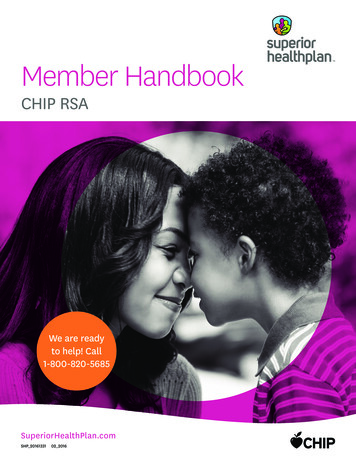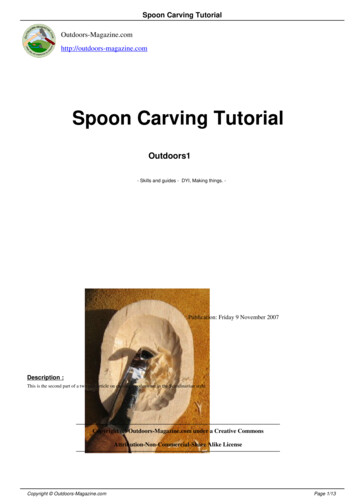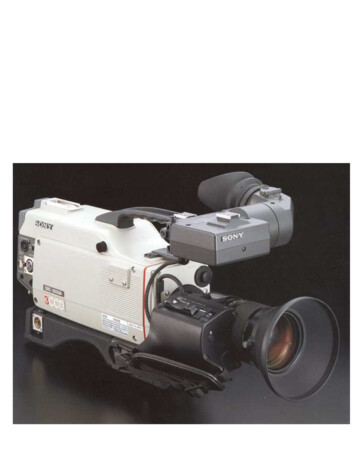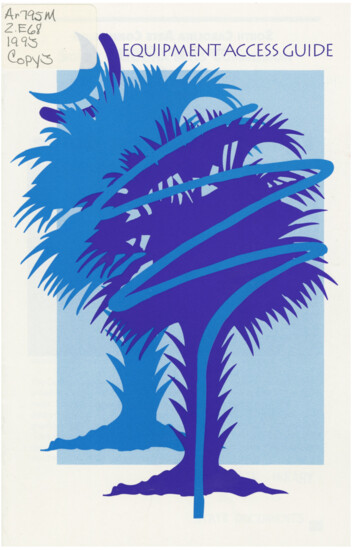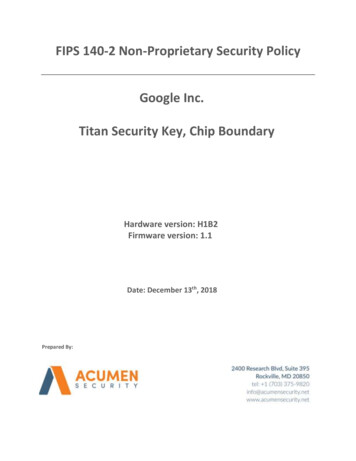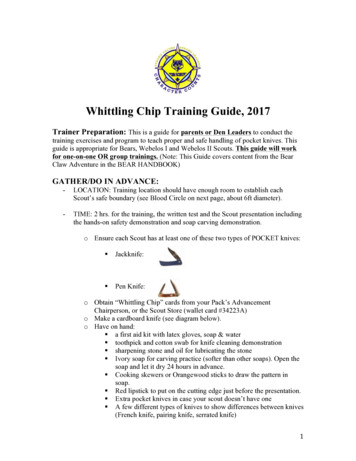
Transcription
Whittling Chip Training Guide, 2017Trainer Preparation: This is a guide for parents or Den Leaders to conduct thetraining exercises and program to teach proper and safe handling of pocket knives. Thisguide is appropriate for Bears, Webelos I and Webelos II Scouts. This guide will workfor one-on-one OR group trainings. (Note: This Guide covers content from the BearClaw Adventure in the BEAR HANDBOOK)GATHER/DO IN ADVANCE:-LOCATION: Training location should have enough room to establish eachScout’s safe boundary (see Blood Circle on next page, about 6ft diameter).-TIME: 2 hrs. for the training, the written test and the Scout presentation includingthe hands-on safety demonstration and soap carving demonstration.o Ensure each Scout has at least one of these two types of POCKET knives:§Jackknife:§Pen Knife:o Obtain “Whittling Chip” cards from your Pack’s AdvancementChairperson, or the Scout Store (wallet card #34223A)o Make a cardboard knife (see diagram below).o Have on hand:§ a first aid kit with latex gloves, soap & water§ toothpick and cotton swab for knife cleaning demonstration§ sharpening stone and oil for lubricating the stone§ Ivory soap for carving practice (softer than other soaps). Open thesoap and let it dry 24 hours in advance.§ Cooking skewers or Orangewood sticks to draw the pattern insoap.§ Red lipstick to put on the cutting edge just before the presentation.§ Extra pocket knives in case your scout doesn’t have one§ A few different types of knives to show differences between knives(French knife, pairing knife, serrated knife)1
Definition of Terms and ActivitiesThe following is a list of the terms and activities to be taught during this trainingexercise.Establishing The Blood Circle:To establish a “Blood Circle,” grasp the closed pocketknife in your hand. Extend yourarm with the closed knife straight in front of you. Rotate your body to either side whilecontinuing to extend the closed knife arm. No one or thing should be in the imaginarycircle that you have created. Also check your overhead clearance, as this is part of yoursafety circle. If someone enters the circle, the knife should be closed up and laid down.Closing a pocket knife:Hold handle in left hand with fingers safely on the sides. Push against the back of theblade with the heel of the right hand (sometimes easier for them to use the fingers insteadof the heel), swing handle up to meet the blade. Let knife snap shut.Passing a knife:Always have the blade closed – never pass an open knife. The receiver should say“Thank you” to indicate that they have a good grip on the knife when taking it.Sharpening a knife:1. It the stone is large enough, place it on a level surface. Placing the stone on adishtowel may limit slipping.2. Wet the stone with a little water or oil (depending on the type of stone), unless it’sa dry or diamond stone.3. Hold the handle of the knife in one hand and if the stone is on the table, place thefingers of your other hand. On the flat of the blade as you lay the knife flat on theblock with the blade facing away from you. Raise the knife slightly to bevel theedge of the blade forsharpening (about the widthof the blade itself). Keepthe knife at the same angleat all times.4. Push the knife away fromyou, just like you are trying to carve a thin slice off the top of the stone, putting.5. pressure on it as you slice. Repeat this PUSHING stroke 3 or 4 times. Try to keepthe same sharpening angle.6. all the time, since this is the key to obtaining the sharpest edge.7. Turn the blade over. Place it at the far end of the stone and repeat the process onthe other side an equal number of times by PULLING the knife toward you.8. Wipe the blade off on a rag or towel. It will take 30 minutes to sharpen a dullknife, but once sharp, a minute a day will keep it in perfect shape.Additional Den Leader Training r/ptc/whittlinchip.htm2
Training CourseIntroduction: Your Cub Scout knife is an important tool. You can do many usefulthings with its blades, but must be very careful and alert when you whittle or carve. Takegood care of your knife and always remember that a knife is a tool, not a toy. Use it withcare so that you don’t hurt yourself or ruin what you are carving.Caring for your knife:-A knife is a tool, not a toy.Never use your knife on something that will dull or break it (rocks, metal, cement,etc.)Never use your knife to cut living trees or plants, or poke it in the dirt. Moistureand dirt will ruin your knife.Keep your knife out of the fire. The heat will ruin the temper of the steel makingthe knife-edge soft and useless.Do not carve your initials into anything that does not belong to youKeep your knife dry and keep the blade clean. Wipe the blade before closing it.Clean your knife by hand; the heat and steam of the dishwasher can dull anddamage the knifeSafety Rules:-Establish a “Blood Circle”. Before you pickup your knife to use it, stretch yourarm out with closed pocketknife in hand and turn in a circle. If you can’t touchanyone else, it’s safe to use your knife. Demonstrate the “Blood Circle”.Be alert; it may not be you who makes the mistake. Someone else may enter yourBlood Circle by not being alert.When closing the blade, do so with the palm of your handAlways cut by pushing the knife away from you. Be sure your hands and body areout of the way.Never carry an open pocketknife.Always walk when carrying your knife – never run with it.Never throw your knife; it could easily deflect and hurt someone, or ruin theknife.A sharp knife is safer because it’s less likely to slip and cut you. A sharp knifewill “bite” the wood. Know how to sharpen your knife.When using the cutting blade, don’t make big shavings or chips. Easy does it. Becareful not to cut yourself or anyone nearby.When you are not using your knife, close it and put it away. An open knife couldhurt someone who doesn’t realize it’s there.Discuss cross contamination of food and the importance of cleaning the knife, notjust wiping it off.3
Taking Your Knife With You:Knives are usually used as tools, but they can be weapons too. Many places do not allowknives. Always keep your knife at home unless your parent or Den Leader tell youotherwise. Places where knives are prohibited even if you have your Whittling Chip cardwith you:- Knives are NOT allowed at School- Knives are NOT allowed at Outdoor school events (school football games)- Knives are NOT allowed at Airports- Knives are NOT allowed at pack or den meetings, even after the Whittling Chip isobtained- Knives are NOT allowed to be used at campouts unless there is adult supervision- You must carry your Whittling Chip” card whenever you are using your knife.o If you break any of the rules, a corner of the Whittling Chip card will becut off.o When the 4th corner is cut off, the card will be taken from you.o If that happens, you must go through training again, in order to receive anew card.o Any adult who feel safety has been violated can do the cutting of corners.o For very serious infractions (such as threatening another scout), the cardwill be taken immediately.- Cub Scouts (even Webelos) are not allowed to use an axe. Boy Scouts must earnthe Totin’ Chip card. Webelos can use a bow saw after training.Your knife and its sharpening stone are partners; where one is, the other should be also.Hands on Training:1. Discuss the difference between whittling and woodcarving.2. Display different type of knives - knives with locking, non-locking blades, andfixed blades (not allowed). Scouts will be shown a French knife, pairing knife,and a serrated knife. Each will be explained for what they are used for. All typesof knives must be treated with the same respect and safety rules.1. Demonstrate how to safely open and close a pocket knife2. Demonstrate how to pass a knife. (Blade closed, Insist on “Thank You”)3. Pass around the Cardboard Knife and have them practice Open, Close and Passthe knife.a. Apply red lipstick to the cutting edge of the cardboard knife.b. The lipstick will transfer to the scouts hands if he unsafely handles thecutting edge.4. Collect the Cardboard Knife, then check for lipstick on fingers5. Demonstrate how to sharpen a knife.6. Demonstrate how to clean the knife with toothpick and cotton swap7. Using a bar of soap, demonstrate how to make a “stop cut” and “shaving cut”(Bear Handbook – 19b).8. Demonstrate how to whittle away from yourself, not toward yourself4
If Time Allows.More Hands on Training:-Help each of them in turn to sharpen their knifeDemonstrate the basics of how to carve a bar of soap. Show them how to use theskewer to draw the design, then rough out the basic pattern with their knife, thenrefine it. See “Soap Carving Instructions” for details.Give them a bar of soap and let them select a soap pattern and work on their own.Remind them to use a “stop cut” and make shavings not big chunks.Final Quiz and hands-on Demonstration:Have your scout take the written quiz and then have them preform the hands ondemonstration of knife handling skills:- Opening / closing the knife- Demonstrating the establishing of a blood circle- How to hold the knife safely- How to sharpen the knife safely- The soap carving demonstrationThe Scout can take the Whittling Chip written test online. The Parent or AdultLeader hands on demonstration review forms can be completed online. Follow theselinks:Scout Written Test: https://goo.gl/forms/FhiLwRxbYbUzdpRP2Parent / Adult Leader review: https://goo.gl/forms/wLw4t6KSACZ0ADWk1If you or your scout cannot access the online tests, please use the included writtentest and email your results to cubmaster@mvpack34.org .Deadline for submitting completed written tests is August 15, 2017.5
Whittling Chip Quiz:Part I: Circle the correct answerTrue / FalseTrue / FalseTrue / FalseTrue / FalseTrue / FalseTrue / FalseTrue / FalseTrue / FalseTrue / FalseTrue / FalseTrue / FalseTrue / FalseTrue / False1. It’s OK to carry my knife to a Pack Meeting or school as long as I have my Whittling Chip card.2. As long as I get permission to bring my knife, I don’t need to have my Whittling Chip card with me.3. Only a leader or your parent can cut off corners. Someone else’s parent cannot.4. It’s OK to bring your knife to a den meeting, if your Leader asks you to and your parents approve.5. It’s OK to cut toward yourself.6. It’s OK to pass an open knife as long as you’re very careful.7. A dull knife is safer than a sharp knife.8. Dirt on a knife blade helps keep it sharp.9. Never carve your initials on anything that does NOT belong to you.10. When someone hands you a knife you say “Thank You” to show good manners.11. A pocketknife should always be closed when it is not in use, or in your pocket.12. You should close the blade with the palm of your hand13. A Cub Scout should carry a fixed blade knife if it is kept in a sheath.Part II: Fill in the blank1. Close the blade with the of your hand.2. A should never be used on something that will dull or break it.3. People watching you work with your knife should not enter your .4. Your knife should always be kept and .5. Always when carrying a knife.Part III: Circle the correct answer1. When using a knife, do not make ( big / little ) shavings or chips.2. A ( dull / sharp ) knife is more likely to cut you.3. A knife should be cleaned ( before / after ) cutting food.4. A fixed blade knife should be passed to another person ( blade / handle ) first.Part V – The Pocketknife Pledge: Fill in the blank1.2.3.4.5.I will treat my pocketknife with the due a useful tool.I will always my pocketknife and put it away when not in use.I will not use my pocketknife when it might someone near me.I never to throw my pocketknife for any reason.I will use my pocketknife in a safe manner at times.
Whittling Chip Attendance:Scout Name12345678910111213141516171819Den #Den Leader Name
Cardboard Knife:The following picture will help you to make a cardboard knife to use for the presentation. The picture below is actualsize, so you can print it out and use it as a template to make the knife parts. Red lipstick should be applied to thecutting edge just before the presentation, in order to see if the scouts can open, close and pass a knife safely.
Snapshot of AdventureA pocketknife is a useful tool to have for S coutingactivities. It can also be dangerous if you don’t use it the rightway. In this adventure, you will learn how to use apocketknife safely. You will also get to learn the basics ofcarving.A Scout is trustworthy. You can show that you aretrustworthy by taking care of your pocketknife andusing it safely.
REQUIREMENT 1 Learn about three commondesigns of pocketknives.
Pocketknives come in all shapes and sizes. Some can be usedfor many different tasks. Others are designed for special purposeslike fishing.Three common designs used in Scouting are the jackknife, thepenknife, and the multipurpose knife. Let’s look at each type.JackknifeA jackknife is a good tool for campers and fishermen. It ishinged at only one end and may have one or two blades. Sometimesone blade has a very sharp point, while another blade has a morerounded point.Some jackknives (and other knives) have locking blades. Thatmeans you have to push a release before you can close the blade.
Locking blades prevent you from accidentally closing the blade onyour fingers.PenknifeA penknife is small and lightweight, so it is easy to carry inyour pocket. It is hinged at both ends and usually has one or twoblades at each end. Penknives were originally designed to cut orsharpen quills used for writing. Thomas Jefferson wrote theDeclaration of Independence with a quill pen.
Multipurpose KnifeM ultipurpose knives can be used to do many things. Inaddition to one or two blades, a multipurpose knife might include acan opener, scissors, leather punch, tweezers, and screwdrivers.
These knives can be fun to have, but all those extra pieces canget in your way when you are just trying to carve or cut somestring. Also, the more tools your knife includes, the heavier it will
be. Pick a multipurpose knife that has only the tools you reallyneed.
REQUIREMENT 2 Learn knife safety and earn yourWhittling Chip.**One of the items carved for Bear Claws requirement 3 may be used to fulfillWhittling Chip requirement 3.It is very important to be safe when you use your pocketknife.
In this requirement, you will learn the rules of knife safety and earnyour Whittling Chip. When you have earned your Whittling Chip,you will be allowed to carry your pocketknife to designated CubScout activities. Your parent or den leader will tell you when youmay bring your knife. Always keep your Whittling Chip card withyou when you are carrying your knife.A Scout is obedient. When you follow the rules of knifesafety, you keep yourself from getting hurt and youshow that you are obedient.Knife Safety Rules to Learn and Live ByA knife is a tool, not a toy.Know how to sharpen a knife. A sharp knife is safer than adull knife because it is less likely to slip and cut you.
Keep the blade clean and dry.Never carry an open pocketknife.When you are not using your knife, close it using the palmof your hand and put it away.When you are using the cutting blade, do not try to make bigshavings or chips. Cut slowly and steadily.M ake a safety circle. Before you pick up your knife to useit, stretch your arm out and turn in a circle. If you cannottouch anyone or anything else, it is safe to use your knife.While using your knife, be sure to watch in case someonewalks toward you and gets too close. If that happens, putyour knife away until it is safe to continue.Always cut away from you, never toward you.Never hand a knife to someone else blade first. Learn and usethe “eye contact” method of handing a knife to someoneelse. Do not release the knife until the other person makeseye contact with you and acknowledges he is receiving theknife.
Never use a knife on something that will dull or break it.Never throw a knife for any reason.Always think before you cut. Do not use your knife to stripbark from a tree or to carve your initials into something thatdoes not belong to you.
Once you understand the safety rules, agree to abide by thePocketknife Pledge, and have your den leader sign your card, youwill have earned your Whittling Chip.
POCKETKNIFE PLEDGEI understand the reason for safety rules.I will treat my pocketknife with the respect due auseful tool.I will always close my pocketknife and put it away whenI am not using it.I will not use my pocketknife when it might injuresomeone near me.I promise never to throw my pocketknife for anyreason.I will use my pocketknife in a safe manner at all times.Keeping Your Knife SharpA good way to sharpen your knife is to use a sharpening stone.Lay the blade on the stone at a slight angle. Push the blade forwardas if you were going to shave a thin sliver from the stone. Do notpush down hard. Next, turn the blade over and shave the stonetoward you. This is the only time you should move your knifetoward yourself. Keep your fingers below the surface of the stone
to protect them. Continue this back-and-forth action until the edgeis sharp along its entire length.Making Stop CutsHere is a secret to use when you are whittling. Before you makea shaving cut, make a stop cut. At the place you want the shavingto stop, cut straight down with your knife. Press down and rockthe blade back and forth until the cut is as deep as you want theshaving to go. This stop cut will prevent you from shaving off toomuch wood.
First Aid for Knife CutsAccidents can happen even when you are being careful. It isimportant that you know what to do if you or one of your fellowScouts gets cut while using a pocketknife.Small cuts in the skin can allow bacteria to enter the body andcause infection. Wash minor cuts with soap and water. Applyantibiotic ointment and cover with a dry, sterile dressing or anadhesive bandage to help prevent infection and protect the wound.Clean and rebandage wounds each day. If the cut is more serious,get help from an adult immediately.Taking proper care of a wound will help prevent other health
issues like an infection.
REQUIREMENT 3 Using a pocketknife, carve twoitems.It is fun to whittle sticks, but it is even more fun to makecarvings of things like animals, acorns, and space aliens. A goodway to learn to carve is to practice with a bar of soap. Carve asimple item and then try something a little harder.
What You Will NeedA large bar of soap—it is best to unwrap the soap and let itdry for a day or two before you start carvingA pocketknifeOne or two orangewood sticks (used for manicures) or asheet of tracing paperPaper for sketching a design or a preprinted patternA tray to work on—this will keep chips and shavings fromgoing everywhere
What To Do1. Choose a simple design that does not have too manyprojections or fine details. Start simple. You can pick afancier design for your next carving.2. Prepare the soap. Cut away the raised edges on the soap andscrape off the lettering. This will give you a nice, smoothblock to work with.
3. Sketch the outline of your design on the soap. You can dothis by drawing with an orangewood stick or by tracingyour design using tracing paper.
4. M ake your first rough cuts. Cut away small pieces and slicesof the soap that are not part of your design. Do not cut bigpieces; if you do, the soap might break. Leave a margin ofabout one-quarter inch outside your outline.5. Shape the model. Continue carving so you get closer andcloser to your outline. Keep turning the soap to work on allparts of your design. Do not try to finish one part beforeanother. Pay special attention to high points and low pointson the carving.
6. Polish your carving. Let the soap dry for a day or two, thenrub it gently to smooth it out. Use a paper napkin first andthen your fingertips.
7. Add detail. Finally, use your knife to add details like eyes orhair. If you like, create a crisscross pattern to give thecarving more depth.
Introduction: Your Cub Scout knife is an important tool. You can do many useful things with its blades, but must be very careful and alert when you whittle or carve. Take good care of your knife and alway

